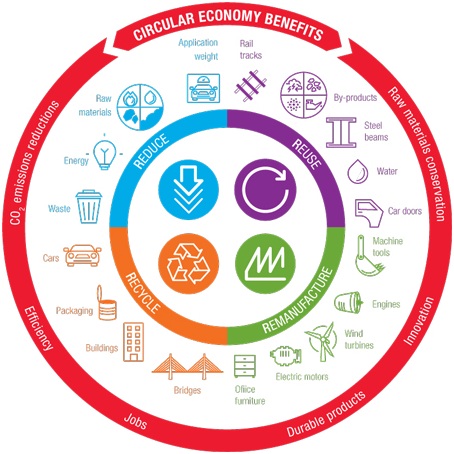

Context
The European Union has called for support to enhance ‘circular economy’ at a working group of the fifth session of the United Nations Environment Assembly (UNEA 5.2).
Analysis
What is the concept of Circular Economy?
- A circular economy entails markets that give incentives to reusing products, rather than scrapping them and then extracting new resources.
- Circular economy, therefore, is a model of production and consumption, which involves sharing, leasing, reusing, repairing, refurbishing and recycling existing materials and products as long as possible. In this way, the life cycle of products is extended.
- In practice, it implies reducing wasteto a minimum. When a product reaches the end of its life, its materials are kept within the economy wherever possible. These can be productively used again and again, thereby creating further value.
- This is a departure from the traditional, lineareconomic model, which is based on a take-make-consume-throw away pattern. This model relies on large quantities of cheap, easily accessible materials and energy.
- This can provide a way to not only protect the environment, but use natural resources more wisely, develop new sectors, create jobs and develop new capabilities.
- In such an economy, all forms of waste, such as clothes, scrap metal and obsolete electronics, are returned to the economy or used more efficiently.
- According to United Nations, the concept of Circular Economy works on the principle - “the goods of today are the resources of tomorrow at yesterday's resource price”.
Why do we need to switch to a circular economy?
- The world's population is growing and with it the demand for raw materials. However, the supply of crucial raw materials is limited.
- Finite supplies also means some countries are dependent on other countries for their raw materials and the supply of the same can be hampered due to various reasons e.g. supply of semiconductors being disrupted due to Russia’s war on Ukraine.
- In addition extracting and using raw materials has a major impact on the environment. It also increases energy consumption and CO2 emissions. However, a smarter use of raw materials can lower CO2 emissions.

What are the benefits?
- Measures such as waste prevention, eco-designand re-use could save money while also reducing total annual greenhouse gas emissions.
- Currently, the production of materials we use every day account for 45% of the CO2 emissions.
What is Eco-design?
Eco design is both a principle and an approach. It consists of integrating environmental protection criteria over a service or a product’s lifecycle. The main goal of eco design is to anticipate and minimize negative environmental impacts (of manufacturing, using and disposing of products). Simultaneously, eco design also keeps a product’s quality level according to its ideal usage.
- Moving towards a more circular economy could deliver benefits such as
- Reducing pressure on the environment
- Improving the security of the supply of raw materials
- Increasing competitiveness
- Stimulating innovation
- Boosting economic growth
- Creating jobs.
- Consumers will also be provided with more durable and innovative products that will increase the quality of life and save them money in the long term.
What are Economic barrier to Circular Economy?
- Social and environmental externalities are not considered in prices. Hence financial market signals instead of people and nature are taken into consideration when economic decisions are made.
- The GDP index doesn’t consider social and environmental externalities, discouraging the creation of value in both these areas.
- Prices of raw materials are fickle and at low therefore good quality secondary resources are not competitive.
- Circular economy business models are harder to develop, as most investors are still working under a linear economy logic and sometimes upfront investments are required which are at this point of time.
- The demand for circular products and alternatives is still small
- There aren’t still many qualified professionals with technical or information and communication technology’ (ICT) knowledge who can be the workforce for Circular Economy.
- Many companies still have goals and appraisal systems that focus on short-term value creation, whereas the circular economy model is a long-term value creation model


